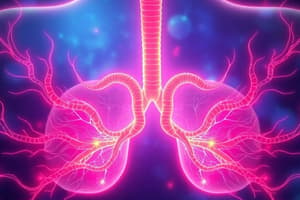Podcast
Questions and Answers
What is the primary function of the adrenal cortex?
What is the primary function of the adrenal cortex?
- Producing catecholamines essential for immediate stress response
- Regulating blood flow to the kidneys
- Producing steroid hormones essential for life (correct)
- Synthesizing neurotransmitters for the nervous system
Which statement accurately describes the structure of the adrenal gland?
Which statement accurately describes the structure of the adrenal gland?
- The adrenal gland has a circular shape with a single layer of cells
- The cortex comprises 80-90% of the gland distinguishing itself from the smaller medulla (correct)
- The adrenal medulla is larger than the cortex and contains more layers
- The adrenal gland is encapsulated by a vascular connective tissue layer
What happens if there is a complete loss of adrenocortical hormones?
What happens if there is a complete loss of adrenocortical hormones?
- It leads to increased levels of catecholamines and potential heart failure
- It results in death due to dehydration and electrolyte imbalances unless replacement therapy is initiated (correct)
- It has no significant effects on bodily functions over a week
- It causes immediate symptoms of excessive energy and alertness
Which hormones are primarily produced by the adrenal medulla?
Which hormones are primarily produced by the adrenal medulla?
What is the approximate size of an adult adrenal gland?
What is the approximate size of an adult adrenal gland?
What percentage of the adrenal gland is made up of the cortex?
What percentage of the adrenal gland is made up of the cortex?
Which of the following layers is found in the adrenal cortex?
Which of the following layers is found in the adrenal cortex?
What is the mass range of an adult adrenal gland?
What is the mass range of an adult adrenal gland?
Which hormone is not produced by the adrenal medulla?
Which hormone is not produced by the adrenal medulla?
What is a critical consequence of not replacing adrenocortical hormones promptly?
What is a critical consequence of not replacing adrenocortical hormones promptly?
Flashcards
Adrenal Gland Location
Adrenal Gland Location
Superior to each kidney in the Retroperitoneal space.
Adrenal Gland Shape
Adrenal Gland Shape
Flattened Pyramidal.
Adrenal Cortex Function
Adrenal Cortex Function
Produces life-essential steroid hormones.
Adrenal Medulla Hormones
Adrenal Medulla Hormones
Signup and view all the flashcards
Adrenal Cortex Zones Function
Adrenal Cortex Zones Function
Signup and view all the flashcards
Adrenal Gland Location
Adrenal Gland Location
Signup and view all the flashcards
Adrenal Gland Structure
Adrenal Gland Structure
Signup and view all the flashcards
Adrenal Cortex Function
Adrenal Cortex Function
Signup and view all the flashcards
Adrenal Medulla Hormones
Adrenal Medulla Hormones
Signup and view all the flashcards
Adrenal Cortex Zones
Adrenal Cortex Zones
Signup and view all the flashcards
Study Notes
Adrenal Gland
- Location: Superior to each kidney, in the retroperitoneal space
- Shape: Flattened, pyramidal
- Size (Adult): 3-5 cm (height) x 2-3 cm (width), less than 1 cm thick
- Weight (Adult): 3.5-5 grams
- Size at birth: Only half the adult size
- Structure: Differentiates into two distinct regions: cortex and medulla
- Cortex: Larger portion (80-90%), located peripherally, produces steroid hormones essential for life
- Medulla: Smaller portion, produces catecholamine hormones (norepinephrine, epinephrine, and dopamine)
- Vascularization: Highly vascularized
- Capsule: Externally covered by a connective tissue capsule
- Hormone Loss: Complete loss of adrenocortical hormones leads to death from dehydration and electrolyte imbalances within a few days to a week, unless hormone replacement therapy begins promptly.
Studying That Suits You
Use AI to generate personalized quizzes and flashcards to suit your learning preferences.

![Clinical Chemistry 2 04 [LEC] Adrenal Gland Prelims A.Y. 2022-2023 Quiz](https://images.unsplash.com/photo-1563886146-e45529b559ff?crop=entropy&cs=srgb&fm=jpg&ixid=M3w0MjA4MDF8MHwxfHNlYXJjaHwyfHxlbmRvY3Jpbm9sb2d5JTIwYWxkb3N0ZXJvbmUlMjAxNy1rZXRvc3Rlcm9pZHMlMjBob3Jtb25lc3xlbnwxfDB8fHwxNzA1ODc2NDY1fDA&ixlib=rb-4.0.3&q=85&w=300&fit=crop&h=200&q=75&fm=webp)


